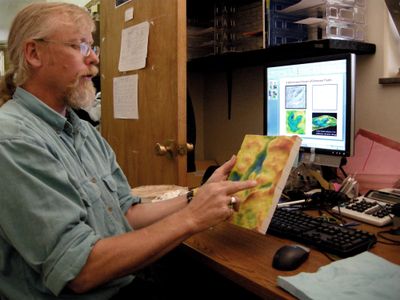Wyoming, Scotland dinosaur tracks alike
Similarity between far-flung sites intrigues paleontologists

LARAMIE, Wyo. – It’s a Jurassic curiosity: As far as anyone can tell, the fossilized, three-toed dinosaur tracks in north-central Wyoming and on Scotland’s coast are indistinguishable.
Even after painstaking measurements and statistical analysis, University of Glasgow paleontologist Neil Clark can’t identify any differences between the two sets of 170-million-year-old tracks.
“The fact that the footprints in Wyoming and the ones in Scotland are so similar suggest that they may have been produced by a very similar kind of dinosaur, if not the same species,” he said during a recent phone interview from his home in Glasgow, Scotland.
If the same dinosaur species made the tracks, the discovery would be as earthshaking as a mighty apatosaurus. No one has ever been able to say for certain that the same dinosaur species was responsible for fossil tracks discovered at separate locations, much less thousands of miles apart.
Now, American scientists are preparing to scrutinize the tracks further, using three-dimensional mapping technology that promises to enable scientists to make detailed, intercontinental comparisons without leaving their offices.
“What we hope will eventually happen is that there will be this huge virtual archive that can be shared worldwide,” said Brent Breithaupt, a University of Wyoming paleontologist. “Tracks can be looked at in three dimensions on computer screens and can be rotated around by various researchers – and can be compared.”
Breithaupt doubts the same dinosaur species made the Wyoming and Scotland tracks. “The tracks are similar, that’s what we know,” he said. “It more than likely indicates similar types of dinosaurs living at higher latitudes at some point in time.”
Most of the tracks Clark examined from the two locations ranged from about an inch long to more than 8 inches, and he compared details such as the length of each toe and the angles between them. He believes the tracks were made by a type of two-legged, carnivorous dinosaur called a theropod.
One set is from the area of Red Gulch in arid north-central Wyoming, where it looks like a flock of Big Birds ran across freshly poured concrete. The others are near the shore of the Isle of Skye off Scotland’s west coast.
Breithaupt and geographer Neffra Matthews followed up Clark’s Red Gulch visit by traveling to the Isle of Skye. They photographed the tracks there and plan to process those photos into three-dimensional images; they already have 3-D images of the Wyoming tracks.
Clark maintains that the same dinosaur species possibly could have made the widely separated tracks, although he doesn’t necessarily think individual dinosaurs migrated that far.
“But that doesn’t mean to say this animal couldn’t range as a species over that distance. It’s quite possible that it did,” he said.